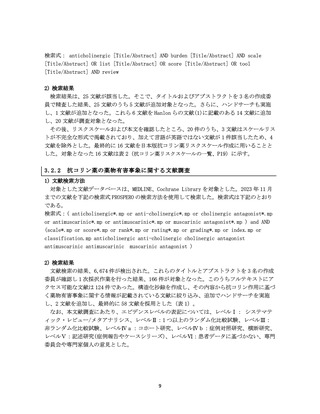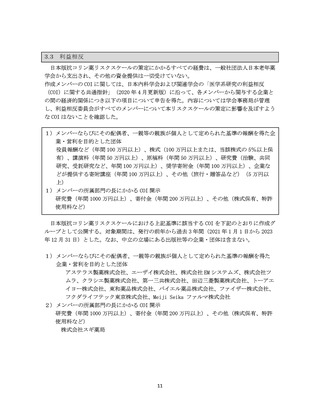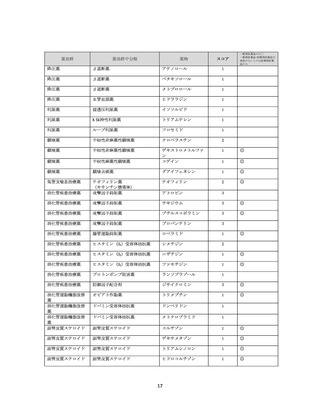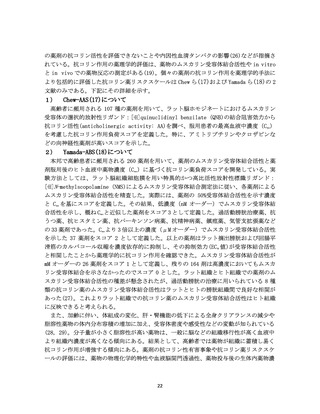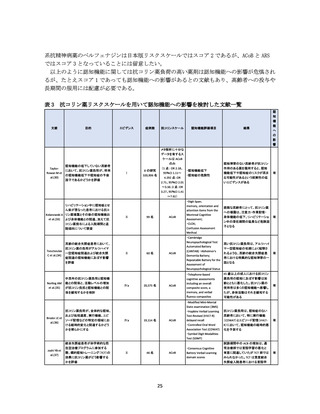よむ、つかう、まなぶ。
資料4-2 日本版抗コリン薬リスクスケール (40 ページ)
出典
| 公開元URL | https://www.mhlw.go.jp/stf/newpage_40741.html |
| 出典情報 | 高齢者医薬品適正使用検討会(第18回 6/21)《厚生労働省》 |
ページ画像
ダウンロードした画像を利用する際は「出典情報」を明記してください。
低解像度画像をダウンロード
プレーンテキスト
資料テキストはコンピュータによる自動処理で生成されており、完全に資料と一致しない場合があります。
テキストをコピーしてご利用いただく際は資料と付け合わせてご確認ください。
37.
Joshi YB, Thomas ML, Hochberger WC, Bismark AW, Treichler EB, Molina J, et al. Verbal learning
deficits associated with increased anticholinergic burden are attenuated with targeted cognitive training in
treatment refractory schizophrenia patients. Schizophrenia research. 2019;208:384-9.
38.
Iyer S, Lozo S, Botros C, Wang C, Warren A, Sand P, et al. Cognitive changes in women starting
anticholinergic medications for overactive bladder: a prospective study. International Urogynecology
Journal. 2020;31:2653-60.
39.
Dyer AH, Murphy C, Segurado R, Lawlor B, Kennelly SP, Group NS. Is ongoing anticholinergic burden
associated with greater cognitive decline and dementia severity in mild to moderate Alzheimer’s disease?
The Journals of Gerontology: Series A. 2020;75(5):987-94.
40.
Haddad C, Salameh P, Sacre H, Clément J-P, Calvet B. Effects of antipsychotic and anticholinergic
medications on cognition in chronic patients with schizophrenia. BMC psychiatry. 2023;23(1):1-13.
41.
Kersten H, Molden E, Tolo IK, Skovlund E, Engedal K, Wyller TB. Cognitive effects of reducing
anticholinergic drug burden in a frail elderly population: a randomized controlled trial. Journals of
Gerontology Series A: Biomedical Sciences and Medical Sciences. 2013;68(3):271-8.
42.
Cicero CE, Monastero R, Terravecchia C, Donzuso G, Luca A, Baschi R, et al. Influence of drugs on
mild cognitive impairment in Parkinson’s disease: Evidence from the PACOS Study. Current
Neuropharmacology. 2022;20(5):998.
43.
Agar M, Currow D, Plummer J, Seidel R, Carnahan R, Abernethy A. Changes in anticholinergic load
from regular prescribed medications in palliative care as death approaches. Palliative medicine.
2009;23(3):257-65.
44.
Hochman MJ, Kamal AH, Wolf SP, Samsa GP, Currow DC, Abernethy AP, et al. Anticholinergic drug
burden in noncancer versus cancer patients near the end of life. Journal of pain and symptom management.
2016;52(5):737-43. e3.
45.
Naicker P, Anoopkumar-Dukie S, Grant GD, Kavanagh JJ. The effects of antihistamines with varying
anticholinergic properties on voluntary and involuntary movement. Clinical Neurophysiology.
2013;124(9):1840-5.
46.
Little J, Broocks A, Martin A, Hill J, Tune L, Mack C, et al. Serotonergic modulation of anticholinergic
effects on cognition and behavior in elderly humans. Psychopharmacology. 1995;120:280-8.
47.
Herrmann ML, Boden C, Maurer C, Kentischer F, Mennig E, Wagner S, et al. Anticholinergic drug
exposure increases the risk of delirium in older patients undergoing elective surgery. Frontiers in Medicine.
2022;9:871229.
48.
Mueller A, Spies CD, Eckardt R, Weiss B, Pohrt A, Wernecke K-D, et al. Anticholinergic burden of
long-term medication is an independent risk factor for the development of postoperative delirium: a clinical
trial. Journal of clinical anesthesia. 2020;61:109632.
49.
Tillemans MP, Butterhoff‐Terlingen MH, Stuffken R, Vreeswijk R, Egberts TC, Kalisvaart KJ. The
effect of the anticholinergic burden on duration and severity of delirium in older hip‐surgery patients with
and without haloperidol prophylaxis: A post hoc analysis. Brain and Behavior. 2021;11(12):e2404.
50.
Caeiro L, Ferro J, Claro M, Coelho J, Albuquerque R, Figueira M. Delirium in acute stroke: a
preliminary study of the role of anticholinergic medications. European Journal of Neurology.
2004;11(10):699-704.
51.
Stewart C, Taylor-Rowan M, Soiza RL, Quinn TJ, Loke YK, Myint PK. Anticholinergic burden measures
and older people’s falls risk: a systematic prognostic review. Therapeutic advances in drug safety.
2021;12:20420986211016645.
52.
Salonoja M, Salminen M, Vahlberg T, Aarnio P, Kivelä S-L. Withdrawal of psychotropic drugs
decreases the risk of falls requiring treatment. Archives of gerontology and geriatrics. 2012;54(1):160-7.
53.
Wilson NM, Hilmer SN, March LM, Cameron ID, Lord SR, Seibel MJ, et al. Associations between drug
burden index and falls in older people in residential aged care. J Am Geriatr Soc. 2011;59(5):875-80.
40
Joshi YB, Thomas ML, Hochberger WC, Bismark AW, Treichler EB, Molina J, et al. Verbal learning
deficits associated with increased anticholinergic burden are attenuated with targeted cognitive training in
treatment refractory schizophrenia patients. Schizophrenia research. 2019;208:384-9.
38.
Iyer S, Lozo S, Botros C, Wang C, Warren A, Sand P, et al. Cognitive changes in women starting
anticholinergic medications for overactive bladder: a prospective study. International Urogynecology
Journal. 2020;31:2653-60.
39.
Dyer AH, Murphy C, Segurado R, Lawlor B, Kennelly SP, Group NS. Is ongoing anticholinergic burden
associated with greater cognitive decline and dementia severity in mild to moderate Alzheimer’s disease?
The Journals of Gerontology: Series A. 2020;75(5):987-94.
40.
Haddad C, Salameh P, Sacre H, Clément J-P, Calvet B. Effects of antipsychotic and anticholinergic
medications on cognition in chronic patients with schizophrenia. BMC psychiatry. 2023;23(1):1-13.
41.
Kersten H, Molden E, Tolo IK, Skovlund E, Engedal K, Wyller TB. Cognitive effects of reducing
anticholinergic drug burden in a frail elderly population: a randomized controlled trial. Journals of
Gerontology Series A: Biomedical Sciences and Medical Sciences. 2013;68(3):271-8.
42.
Cicero CE, Monastero R, Terravecchia C, Donzuso G, Luca A, Baschi R, et al. Influence of drugs on
mild cognitive impairment in Parkinson’s disease: Evidence from the PACOS Study. Current
Neuropharmacology. 2022;20(5):998.
43.
Agar M, Currow D, Plummer J, Seidel R, Carnahan R, Abernethy A. Changes in anticholinergic load
from regular prescribed medications in palliative care as death approaches. Palliative medicine.
2009;23(3):257-65.
44.
Hochman MJ, Kamal AH, Wolf SP, Samsa GP, Currow DC, Abernethy AP, et al. Anticholinergic drug
burden in noncancer versus cancer patients near the end of life. Journal of pain and symptom management.
2016;52(5):737-43. e3.
45.
Naicker P, Anoopkumar-Dukie S, Grant GD, Kavanagh JJ. The effects of antihistamines with varying
anticholinergic properties on voluntary and involuntary movement. Clinical Neurophysiology.
2013;124(9):1840-5.
46.
Little J, Broocks A, Martin A, Hill J, Tune L, Mack C, et al. Serotonergic modulation of anticholinergic
effects on cognition and behavior in elderly humans. Psychopharmacology. 1995;120:280-8.
47.
Herrmann ML, Boden C, Maurer C, Kentischer F, Mennig E, Wagner S, et al. Anticholinergic drug
exposure increases the risk of delirium in older patients undergoing elective surgery. Frontiers in Medicine.
2022;9:871229.
48.
Mueller A, Spies CD, Eckardt R, Weiss B, Pohrt A, Wernecke K-D, et al. Anticholinergic burden of
long-term medication is an independent risk factor for the development of postoperative delirium: a clinical
trial. Journal of clinical anesthesia. 2020;61:109632.
49.
Tillemans MP, Butterhoff‐Terlingen MH, Stuffken R, Vreeswijk R, Egberts TC, Kalisvaart KJ. The
effect of the anticholinergic burden on duration and severity of delirium in older hip‐surgery patients with
and without haloperidol prophylaxis: A post hoc analysis. Brain and Behavior. 2021;11(12):e2404.
50.
Caeiro L, Ferro J, Claro M, Coelho J, Albuquerque R, Figueira M. Delirium in acute stroke: a
preliminary study of the role of anticholinergic medications. European Journal of Neurology.
2004;11(10):699-704.
51.
Stewart C, Taylor-Rowan M, Soiza RL, Quinn TJ, Loke YK, Myint PK. Anticholinergic burden measures
and older people’s falls risk: a systematic prognostic review. Therapeutic advances in drug safety.
2021;12:20420986211016645.
52.
Salonoja M, Salminen M, Vahlberg T, Aarnio P, Kivelä S-L. Withdrawal of psychotropic drugs
decreases the risk of falls requiring treatment. Archives of gerontology and geriatrics. 2012;54(1):160-7.
53.
Wilson NM, Hilmer SN, March LM, Cameron ID, Lord SR, Seibel MJ, et al. Associations between drug
burden index and falls in older people in residential aged care. J Am Geriatr Soc. 2011;59(5):875-80.
40








